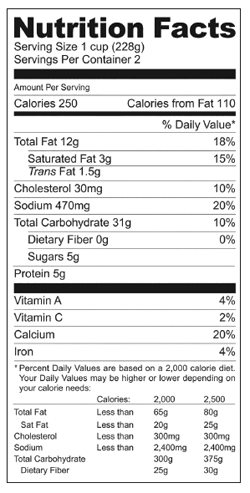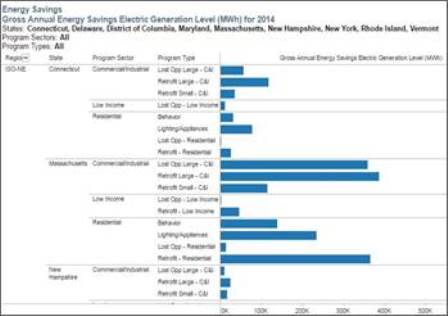By Elizabeth Titus | Thu, July 14, 16
The nutrition label for a banana that’s pictured below is a familiar example of standardization; these labels provide transparent reporting based on established testing. Our society trusts this information, and uses it routinely for cooking and comparison shopping.
 If we look at energy efficiency as a virtual fruit salad –made up of various technologies and practices (“fruits”) delivered in various settings and programs – we can see that in order to fully understand the effect of the savings impacts associated with energy efficiency, we need common metrics -- our own version of food labels.
If we look at energy efficiency as a virtual fruit salad –made up of various technologies and practices (“fruits”) delivered in various settings and programs – we can see that in order to fully understand the effect of the savings impacts associated with energy efficiency, we need common metrics -- our own version of food labels.
Common metrics alone may not assuage concerns about credibility of impacts when we look at efficiency measurement at this time. This is partly because many factors affect how impacts are calculated and used – including analytical methods sample designs and sample sizes, parameters that are examined, the programs, the companies, the regulatory direction, and budgets.
So, in addition to adding a food label to the way we talk about metrics, standardization can make documentation more transparent and accessible. And, it facilitates the transactions in which energy efficiency plays a role, whether they involve benchmarking program performance, relating energy efficiency impacts to economic development and environmental impacts, or finding leveraging evaluation efforts.
Northeast and Mid-Atlantic as an incubator for EE standardization
The good news is that, in the NEEP region, we’re addressing some of these issues. Even better, our region operates on a scale that is well-suited to function as an incubator for developing tools that standardize the use and understanding of energy efficiency data. Policies such as the ISO-NE and PJM capacity markets helped drive development of the tools. NEEP established the Regional EM&V Forum as a multistate collaboration between regulators and program administrators to accelerate and promote standardization. Here are a few of the tools, in varying stages of development:
- A glossary of EM&V terms, including explanations for many of the acronyms that are part of this industry;
- Protocols which helped inform the Uniform Methods Protocols developed by US DOE and which describe, generically, the algorithms recommended for calculating EE and demand impacts from specific technologies;
- A Technical Reference Manual – serving three jurisdictions – to include the most up-to-date evaluation results and defining values for variables in the algorithms used in the energy efficiency programs in Maryland Delaware, and the District of Columbia;
- Consensus-based policy guidance on cost-effectiveness tests and on net and gross savings; these establishing core principles that support decision-making in a more transparent and unbiased fashion;
- Energy efficiency credentialing – the Forum is overseeing some preliminary research for DOE on what an evaluator certification would entail.
These exercises give legitimacy to energy efficiency results and means that the most recent appropriate information about energy efficiency results are shared and can even spread to beyond this region.
Forms and Databases that support standardization
Standardized forms: Much like the nutrition label, standardized forms play an important role in our everyday lives. NEEP created model EM&V Methods Standardized Reporting Forms to document results of individual evaluation studies as well as results of programs overall. The forms are checklists with added flexibility to include comments. In addition to bottom line numerical results, the forms answer the questions: What methods were used? How rigorous was the result? Does it comply with a formal protocol? These forms are available to be piloted; they are one example of how a regional product can shape or contribute to national efforts, as they may help to inform the design of information for the National Energy Efficiency Registry (NEER), which is now in the very early stages of development.
 Regional Energy Efficiency Database (REED): Assembled and used by many kinds of stakeholders, NEEP’s REED database provides one-stop shopping for information as well as assistance in analyzing it. It is a repository for policy as well as quantified information. It is organic, and NEEP is exploring ways to add more dimensions, such as demand response impacts and investments.
Regional Energy Efficiency Database (REED): Assembled and used by many kinds of stakeholders, NEEP’s REED database provides one-stop shopping for information as well as assistance in analyzing it. It is a repository for policy as well as quantified information. It is organic, and NEEP is exploring ways to add more dimensions, such as demand response impacts and investments.
Home Energy Labeling Information Exchange (HELIX): The longterm goal of the HELIX project, which is supported by DOE and seven of NEEP's states (New England plus New York), is to make efficiency part of the “DNA” of real estate transactions by making a database of home energy rating scores seamlessly accessible to individuals in the real estate market. Currently, those scores must be retrieved manually by real estate agents, which discourages the process and limits the diffusion of energy-related information into the home-buying decision-making process. With some states incorporating home energy ratings into their efficiency programs and others proposing an energy label be provided when homes are listed for sale, HELIX is positioned to meet this rising need for energy efficiency standardization in the real estate sector upon its launch in 2018, after which it will serve as a replicable model regionally and nationally as a first-of-its-kind implementation.
Serving up the fruit salad
From its perspective as an incubator, NEEP has learned that in order to succeed in standardizing energy efficiency information and reporting, we must:
- avoid extra burden for our already-busy stakeholders;
- provide structure with long-term goals but also allow flexibility;
- achieve consensus without settling for mediocrity;
- incorporate compatibility with other products and activities;
- encourage implementation and dissemination of products that are created voluntarily.
Transparency and consistency in reporting can only help the industry push forward to continue to take advantage of the fact that energy efficiency is a least-cost resource with an important role in meeting capacity, environmental, and economic development needs. Looking ahead to the next generation of energy efficiency, which integrates distributed resources, AMI and related analytics, we can anticipate need for further evolution of standardization in energy efficiency information.
In the end, making fruit salad is a complex and multi-faceted process, but we all can agree that the final product tastes great.
